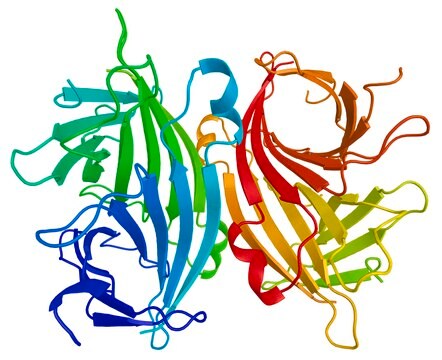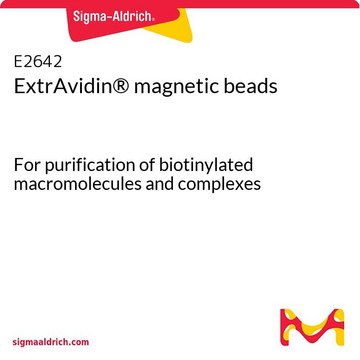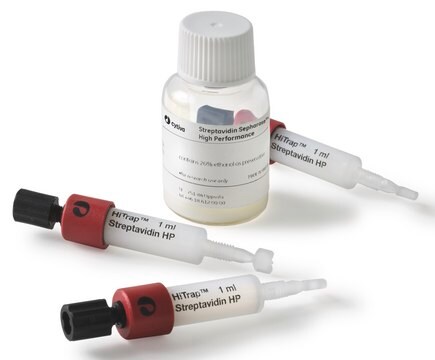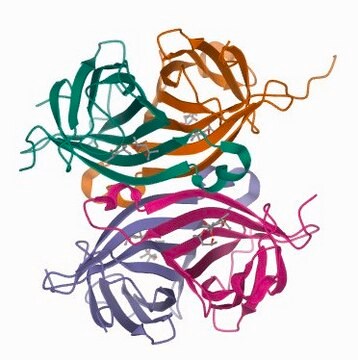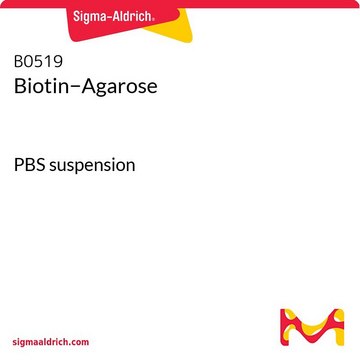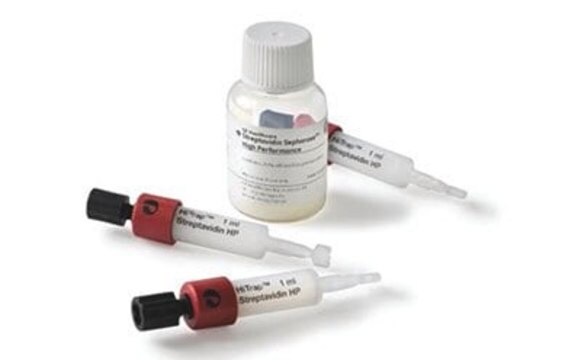E2513
ExtrAvidin®-Agarose, high binding
For purification of biotinylated macromolecules and complexes
Sinonimo/i:
ExtrAvidin® beads, de-glycosylated Avidin
Autenticatiper visualizzare i prezzi riservati alla tua organizzazione & contrattuali
About This Item
Codice UNSPSC:
41106500
NACRES:
NA.56
Prodotti consigliati
Forma fisica
aqueous suspension
suspension
Caratteristiche
For purification of biotinylated macromolecules and complexes
Concentrazione
50%
Matrice
4% agarose (beaded)
Attivazione matrice
cyanogen bromide
Temperatura di conservazione
2-8°C
Descrizione generale
ExtrAvidin® is a unique de-glycosylated Avidin modified form of an affinity purified egg white avidin. The ExtrAvidin is conjugated to cyanogen bromide-activated agarose beads.
ExtrAvidin® is a tetrameric protein containing four biotin binding sites. The Avidin-Biotin high affinity interaction (Kd=10-15M) is considered one of the strongest non-covalent interactions known in nature. The use of Avidin-Biotin complex for affinity purification was described in the first half of 1970 and since then it was successfully utilized in numerous studies and biotechnological applications.1-3 This was achieved due to the ability to chemically coupe the small Biotin molecule with different binders, without disturbing its function or structure, thus allowing unique interaction with a variety of Avidin carriers including: protein or DNA molecules, Avidin protein bound to a solid surface matrix, reporter molecules, probes or carriers,. Among the known Avidin-Biotin interaction based applications are purification, enrichment, detection, amplification and other research medical and industrial processes. In addition, the ExtrAvidin® high specificity binding to Biotin, together with the low background staining, grant it significant advantage compared to the non-modified Avidin or Streptavidin produced by Streptomyces avidinii.
ExtrAvidin® is a tetrameric protein containing four biotin binding sites. The Avidin-Biotin high affinity interaction (Kd=10-15M) is considered one of the strongest non-covalent interactions known in nature. The use of Avidin-Biotin complex for affinity purification was described in the first half of 1970 and since then it was successfully utilized in numerous studies and biotechnological applications.1-3 This was achieved due to the ability to chemically coupe the small Biotin molecule with different binders, without disturbing its function or structure, thus allowing unique interaction with a variety of Avidin carriers including: protein or DNA molecules, Avidin protein bound to a solid surface matrix, reporter molecules, probes or carriers,. Among the known Avidin-Biotin interaction based applications are purification, enrichment, detection, amplification and other research medical and industrial processes. In addition, the ExtrAvidin® high specificity binding to Biotin, together with the low background staining, grant it significant advantage compared to the non-modified Avidin or Streptavidin produced by Streptomyces avidinii.
Applicazioni
ExtrAvidin®-Agarose provides high affinity with high specificity binding to Biotin (also known as vitamin B7) including biotinylated proteins and biotin-tagged fusion proteins. The product may be used in various immunological techniques, including Immunoprecipitation and Immunoaffinity purification.
Avvertenza
DO NOT FREEZE
Stato fisico
ExtrAvidin®-Agarose is provided as suspension at a 1:1 ratio, in 0.01 M phosphate buffered saline, pH 7.4, containing 15 mM sodium azide as a preservative.
Note legali
ExtrAvidin is a registered trademark of Merck KGaA, Darmstadt, Germany
Esclusione di responsabilità
This product is for research use only, not for drug, household, or other uses. Please consult the Material Safety Data Sheet for information regarding hazards and safe handling practices.
Codice della classe di stoccaggio
10 - Combustible liquids
Classe di pericolosità dell'acqua (WGK)
WGK 3
Punto d’infiammabilità (°F)
Not applicable
Punto d’infiammabilità (°C)
Not applicable
Certificati d'analisi (COA)
Cerca il Certificati d'analisi (COA) digitando il numero di lotto/batch corrispondente. I numeri di lotto o di batch sono stampati sull'etichetta dei prodotti dopo la parola ‘Lotto’ o ‘Batch’.
Possiedi già questo prodotto?
I documenti relativi ai prodotti acquistati recentemente sono disponibili nell’Archivio dei documenti.
I clienti hanno visto anche
Samantha Ames et al.
Oncogene, 39(8), 1710-1723 (2019-11-15)
Tumor cells rely on glycolysis to meet their elevated demand for energy. Thereby they produce significant amounts of lactate and protons, which are exported via monocarboxylate transporters (MCTs), supporting the formation of an acidic microenvironment. The present study demonstrates that
Il team dei nostri ricercatori vanta grande esperienza in tutte le aree della ricerca quali Life Science, scienza dei materiali, sintesi chimica, cromatografia, discipline analitiche, ecc..
Contatta l'Assistenza Tecnica.

